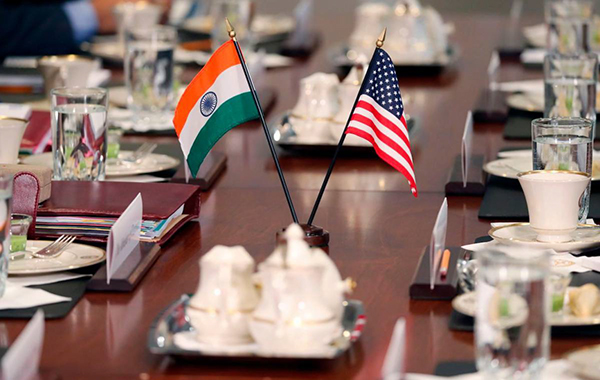In recent years, especially since 2014, with the Narendra Modi government coming to office in India one can notice that the relationship between New Delhi and Washington has entered an altogether revamped phase, both in bilateral framework and in multilateral fora such as UN Security Council, G-20, Quad, Japan-America-India (JAI) alliance and Financial Action Task Force (FATF).
New Delhi views US as one of its key strategic defence partners. After buying about $18 billion worth of defence equipment in recent years, the potential for defence cooperation is still huge. It is hoped that the deepening relationship will not disturb the unique India-Russia equilibrium.
The signing of the four foundational and enabling agreements – GSOMIA, LEMOA, COMCASA and BECA – since 2012, has opened the way to unimpeded transfer of classified information, imagery, data, dual use equipment, and exploitation of hardware. These agreements have been supplemented with the Industrial Security Annex (ISA) and a Statement of Intent and Standard Operating Procedure for the ongoing Defence Technology and Trade Initiative (DTTI), which itself has seen a course correction towards better selection of projects and involvement of industry.
ALSO READ: India-US joint statement riles Pakistan on terror
The 2+2 Dialogue itself exemplifies how much importance the two countries currently provide in acquiring new qualitative edge and purpose towards emboldening shared commitment in dealing with the menace of strategic security issues of mutual interests. Strategic ties between New Delhi and Washington are now perceived by international community to be potent, decisive and impactful in shaping the global geopolitical construct.
The 2+2 Dialogue happened just three weeks after the foreign ministers of the Quad met in Tokyo. Delhi also announced the much-awaited expansion of the annual Malabar exercises with the US and Japan to include Australia.
At the heart of US national interest in making the India strategic partnership more inclusive and compreshensive is the need for enhanced cooperation in maintaining peace and stability especially in the Indian Ocean Region and Indo-Pacific. Such understanding becomes all the more critical especially in the context of growing Chinese aspirations for establishing hegemony and altering power balance in this vital area of global maritime trade. It has become vital to the US for the Quad and the Japan-America-India alliance to supplement Indo-US efforts to maintain peace and stability in the region.
With the US recently designating India as “Major Defence Partner,” a status unique to India, new vistas have opened for elevated Indo-US cooperation impacting power balance in the region and neutralizing shared security threats.
There is no mistaking that under the Narendra Modi-led government, India is not constrained as the UPA government was about China’s sensitivities about India’s relations with the US. Modi has refused to cede a veto to China over its policy on security cooperation with the US — whether bilateral or in multilateral formats such as the Quad. The Covid pandemic has also forced Delhi to reduce its commercial ties to Beijing in response to the PLA’s Ladakh aggression. This has created the conditions for a new conversation between India and the US on rearranging global supply chains away from China in the so-called Quad Plus conversations that have variously drawn in Brazil, Israel, New Zealand, South Korea and Vietnam.
Although Delhi and Washington continue to have many differences over bilateral trade, they both see the need for rethinking the current global economic institutions that China has bent to its own advantage.
Delhi and Washington are now focused on finding ways to collaborate on the critical technologies of the 21st century and work with their partners in setting new global rules for managing them.
The overarching framework that has emerged across different administrations in the last two decades helps manage potential difficulties and take advantage of new opportunities.
Both Delhi and Washington have benefited much from the recent political investments in the relationship. As the regional and global order faces multiple transitions, the incentives for Delhi and Washington to sustain and advance India-US partnership are stronger than ever before and will continue into the next administration.
Mafia’s Hold Over Bollywood
Col Shaili Sharma’s lead article on the dark underbelly of Bollywood and the influence of the anti-India pro-Islamist-Leftists on movies which have hidden agendas is an eye-opener.
He makes out a valid case to investigate why many movies are scripted in a manner to create a divide in the society and the country. Everybody is aware of Dawood Ibrahim funding Bollywood for a very long time. In the last two decades things have worsened. Now Dawood is a front of ISI and is efficiently used by Pakistan and other Islamist groups to run their propaganda.
There is a need to go into who directly or indirectly funds divisive films; funds flowing through hawala route; control over distribution and exhibition; the rise of multiplex chains that have increased the stranglehold of Bollywood Mafia and ensured that outsiders’ films are not released or they do not get adequate screens.
Everybody is aware of Dawood Ibrahim funding Bollywood for a long time. In the last two decades things have worsened. Now Dawood is a front for ISI and is used by Pakistan and Islamist groups to run their propaganda.
Bollywood urgently needs an alternate team of talented professionals who can identify, nurture, and promote talent, identify good scripts, create pro-India production and distribution houses making nationalist content.


















